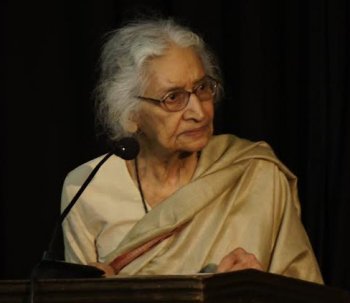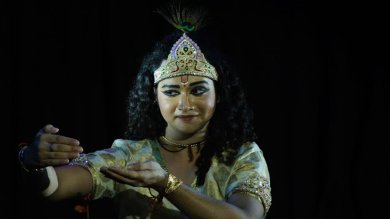
|   |

|   |
A world of dance on World Dance Day - Shveta Arora e-mail: shwetananoop@gmail.com Pics: Anoop Arora June 11, 2015 Geeta Chandran and Natya Vriksha hosted the 2015 edition of World Dance Day on April 25 and 26 at India International Centre, New Delhi. The whole auditorium was filled with the scent of mogra flowers which were spread out on the stage. On the first day of the event, the evening opened with a grand book launch of renowned dance critic Leela Venkatraman’s book Indian Classical Dance - The Renaissance and Beyond. Venkataraman is a prolific writer, a contributor to dance journals and the author of several books. The dais featured a galaxy of star speakers - Guru Singhajit Singh, Lakshmi Vishwanathan, Dr. Kapila Vatsyayan, Shanta Serbjeet Singh and Pavan K Varma. People were squatting in the aisles to watch the proceedings.  Dr. Kapila Vatsyayan
Leela Venkataraman with her extensive knowledge of music and many forms of dance, delves into the technique, literature and other nuances of these dance forms. She ardently follows the old school approach to classical dance forms and her candid criticism has always been an eye-opener. “It’s been a wonderful evening on a Saturday. I didn’t think so many people would turn up for a book launch. Do people have that kind of interest in dance, or it appears that you’re writing for the wall, and nobody’s listening. I had this tremendous urge to capture the last 60-70 years of dance in a book. At least it is on record. Things have slowly changed, though people think nothing changes in dance. But one doesn’t know whether what changes is good for the art or whether it destroys some of the delicate sensibilities of the art form. For that, I think, thinking is necessary. There should be smaller performance spaces where people can do an inward-looking piece rather than doing something big full of glamour, noise and loud mannerisms. There have to be silences.Those silences which speak.These speaking silences are lost in the midst of noise and if we don’t capture them, we lose something precious,” said Leela Venkataraman. The next section titled Navdarshanam was group choreographies by senior dancers of Natya Vriksha Dance Company. These compositions have been visited before by Geeta Chandran and her disciples, but here, they introduced new movements and formations to each piece to bring about new interpretations to the choreography. The first piece was a mallari performed in a group by Sneha Chakradhar, Divya Saluja and Radhika Kathal. A mallari depicts the procession of the deity in the temple and has intricate rhythmic patterns. The dancers exhibited crisp straight lines and angular movements. The next piece was Samyukta performed by Sharanya Chandran and R Amrita Shruthi. Music for Samyukta was arranged by Geeta Chandran, composed by Sudha Raghuraman and G. Raghuraman with vocal support by Sudha Raghuraman, rhythmic inputs and mridangam by Karaikudi Sivakumar and flute by G. Raghuraman. The music goes through crests and troughs and so do the movements. The dancers explored slow movements with aalap and the rhythmic movements were executed with perfection. The abhinaya piece, a javali by poet Dharmapuri, depicts khandita nayika, who has been waiting for her lover the entire night. She strings flowers, puts it on her head, wears her ornaments and adorns her bed with flowers. She stays up the entire night and he shows up in the morning in a dishevelled state. She tells him that his behaviour is unacceptable, that he’s like a flitting bumblebee. This piece was taught and choreographed by Jamuna Krishnan during an abhinaya session. Omkarakarini by Sharanya and Amrita is a Devi Stuti in Lavangi ragam, sung by OS Arun. The dancers used interpretive gestures and stances with grace, depicting the Devi as the destroyer of evil but gentle towards her devotees. The final piece Natanam Adinar was well interpreted as a group choreography by Sneha, Divya and Radhika. The first day ended with the screening of an international film Vara, which features Geeta Chandran, directed by Khyentse Norbu Rinpoche.  Senior disciples of Natya Vriksha  Reddi Lakshmi The second evening featured T Reddi Lakshmi, an upcoming dancer of the present generation of Kuchipudi artistes, a disciple of Jayarama and Vanashree Rao. Lakshmi chose to perform to numbers focussing on abhinaya. She began her recital with a composition in praise of Goddess Tripurasundari, an invocation performed at the beginning of a Kuchipudi recital. Lakshmi brought a mangalpatra (brass pot with a leaf) to purify the directions, drawing rangoli on the floor and performing a pushpanjali. Next was a composition by Swati Tirunal describing Lord Krishna’s beauty and his deeds. The story of Draupadi when she was dragged to the court of the Kauravas and rescued by Lord Krishna was depicted. The bhajan was choreographed by Jayarama and Vanashree Rao. The elaboration of the piece began with raas, Holi and other leelas of Krishna in Vrindavan. He is depicted with the four-armed stance as Padmanabha. The story of Draupadi began with the dice game between the Pandavas and Kauravas, and the shrewd Shakuni was portrayed by Lakshmi as limping around and laughing with heaving shoulders. Draupadi is dragged to the court and Krishna saves her modesty by becoming the sari that wraps her. In the next piece, Satyabhama writes a letter to Krishna as she cannot bear separation from him. The breeze, the moonlight, the birds and the bees, all remind her of Krishna. She pleads with him to come back to her. The composition is from Bhama Kalapam in raga Arabi. The next piece in ragam Kedaragowla and roopaka talam was about the khandita nayika who is angry with the hero. She says, “You seldom visit me. Last night I sent my sakhi to fetch you, but you declined. Remember the days we have played together as children.” In the next piece, the stories of Putana vadham and Kamsa vadham were interwoven, starting with the shloka ‘vanshi vibhushita navaneeradha pitambara’ in praise of Lord Krishna. Lakshmi gave a convincing portrayal as mother Yashoda feeds little Krishna, wipes his face and puts him to sleep, Putana’s excruciating pain as Krishna sucks out her life. The vanquishing of Kaliya and Kamsa were then portrayed. Finally, Lakshmi danced on a brass plate with a pot of water on her head. Reddi Lakshmi’s movements have an exactitude about them, though she missed the taal a few times, which her guru caught immediately.  Vishal Krishna
The grand finale of the event left the audience agape. It was a powerful performance by Vishal Krishna, who belongs to the 11th generation of dancers of the Benaras gharana. He has trained under the strict tutelage of his grandaunt Kathak queen Sitara Devi. He started the performance with a Ganga stotra. Ganga resides on the head of Shiva and has the purest of water. She is Bhagawati Gange, whose praises have been sung by all. She originates at the feet of Lord Krishna. It was a neatly done piece, followed by an interlude of tabla. This was followed by pure nritta in teen taal vilambit in 14 matra, bandish, aakash bhramari, leaps, footwork, khula sam, bolon ki jugalbandi, gaton ki mala, jump and a squat for sam, pirouettes, swirling while sitting, tatkaar and finally, dancing on the edge of a plate. Vishal said some pairon ki uthan, todey, tukdey, paran and a few special things were taught to him specially by Sitara Devi. Finally, shuddering of the feet to create the sound of ghungroos, ended with Vishal dancing standing on the rim of a plate. The lighting for this piece created shadows of the dancer on both the side walls. The sequence of nritta left the audience spellbound since the body that is dancing is young, agile, energetic, flexible, can jump, leap, swirl, pirouette, and squat like an acrobat, plus the strong taal and beats by the pakhawaj and tabla left the audience amazed. The final piece was a Surdas composition choreographed by Madhavi Mudgal, with music by Madhup Mudgal. The piece is about Radha and Krishna’s first meeting. The emotions brought out are the shock of Krishna when he sees Radha, and then his admiration of her beauty. Radha and Krishna converse through the eyes. Krishna asks Radha about where she comes from or whose daughter she is, and invites her to come to his palace to play. When Radha refuses to because Krishna is famous as a thief, Krishna retorts that he hasn’t stolen anything of hers. Vishal’s depiction of the first glimpse that Krishna has of Radha, his gaze moving from her head to toe, and finally, the exchange of looks between the two, the emotion of love at first fight, was mesmerizing. About the choreography, Madhavi Mudgal said, “Last year, during a festival, I did a dhrupad with Vishal. And now, he wanted to do some more abhinaya, which is a wonderful thing since young Kathak dancers are not interested in abhinaya. I chose these two padavalis for him, and for a dancer who’s starting out, he did well. I concentrated more on the abhinaya for the piece, since that was the demand of the composition.” Shveta Arora is a blogger based in Delhi. She writes about cultural events in the capital. |